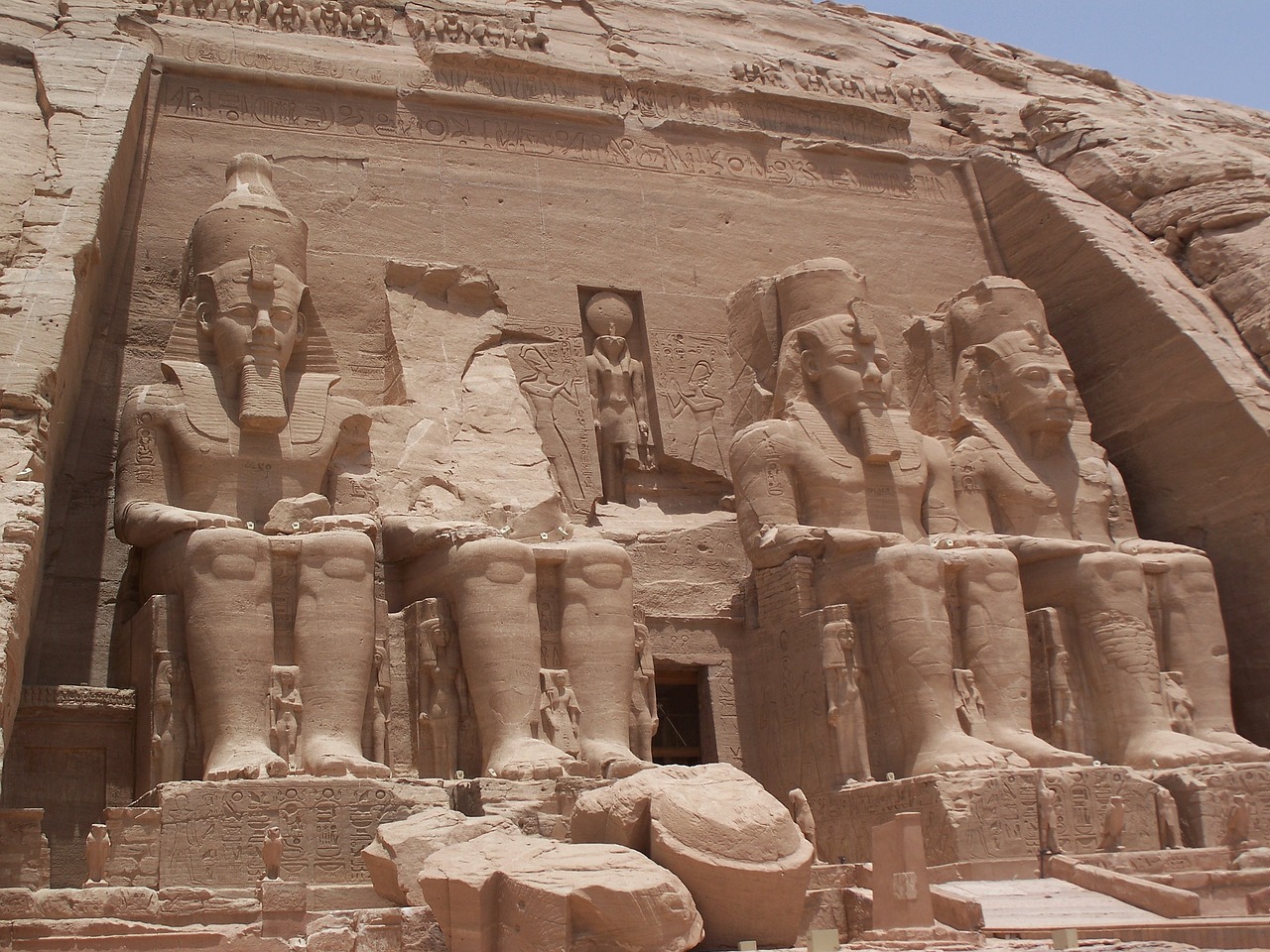The Cultural Exchange of Ancient African Civilizations
Exploring the interconnectedness and influences of ancient African civilizations reveals a fascinating tapestry of traditions, beliefs, and practices that have shaped the continent's diverse societies. Through trade, migration, and cultural diffusion, these civilizations have exchanged knowledge, goods, and ideas, creating a rich mosaic of cultural heritage that continues to resonate through the annals of history.

Trans-Saharan Trade Routes
The Trans-Saharan trade routes were crucial pathways that connected the Mediterranean civilizations of North Africa with the indigenous societies of West Africa. Caravans laden with goods such as gold, salt, ivory, and slaves traversed the vast desert expanse, creating a bustling network of trade and cultural exchange. This exchange was not merely about goods but also about the transmission of ideas, technologies, and beliefs, shaping the identities of the regions involved.
Imagine the spectacle of camel caravans snaking their way through the shifting sands, carrying treasures from distant lands and fostering connections between peoples separated by harsh terrain. The trade routes were not just conduits for commerce but also for the flow of knowledge, languages, and customs, enriching the cultural landscape of both North and West Africa.
At the crossroads of these routes, vibrant market towns emerged, bustling with activity as merchants from different regions converged to exchange their wares. These towns became melting pots of diversity, where languages blended, traditions intertwined, and new ideas took root. The Trans-Saharan trade routes were not only economic arteries but also cultural bridges that spanned vast distances and connected disparate societies.
The impact of the Trans-Saharan trade routes reverberated far beyond the realm of commerce. They facilitated the exchange of architectural styles, artistic motifs, and religious practices, leading to a fusion of North African Islamic influences with the indigenous beliefs of West Africa. This cultural synthesis gave rise to unique art forms, architectural marvels, and social structures that reflected the interconnectedness of the region.
As the caravans traversed the desert, they carried not only goods but also stories, legends, and traditions passed down through generations. The Trans-Saharan trade routes were not just about transactions but about the weaving together of the fabric of diverse cultures, creating a tapestry of shared experiences and mutual enrichment that endured through the ages.

Swahili Coast and Indian Ocean Trade
Exploring the interconnectedness and influences of ancient African civilizations through trade, migration, and cultural diffusion, shedding light on the rich tapestry of traditions, beliefs, and practices that shaped the continent's diverse societies.
The Swahili Coast, situated along the shores of the Indian Ocean, served as a melting pot of cultures, where African, Arab, Persian, and Indian influences intertwined to create a vibrant and diverse society. The bustling trade networks that crisscrossed the Indian Ocean connected distant lands, facilitating the exchange of goods, ideas, and technologies. This cultural fusion not only enriched the region but also played a pivotal role in shaping the unique identity of the Swahili Coast.
Traders from across the Indian Ocean brought spices, textiles, and precious metals to the Swahili Coast, while local merchants exported goods such as gold, ivory, and slaves. This exchange of commodities not only fueled economic growth but also fostered cultural diversity, as different traditions and practices intermingled along the bustling ports and markets.
The architecture of Swahili city-states, characterized by intricately carved wooden doors, coral stone buildings, and mosques with distinct Swahili-Arab influences, reflects the synthesis of diverse cultural elements. The Swahili language, a blend of Bantu languages and Arabic, emerged as a lingua franca in the region, further illustrating the cultural amalgamation that defined the Swahili Coast.
Moreover, the Swahili Coast served as a hub for intellectual exchange, where scholars, poets, and traders from various backgrounds congregated to share knowledge and ideas. This intellectual cross-pollination gave rise to a rich literary tradition, with works in Arabic and Swahili exploring themes of love, religion, and societal norms.
In essence, the Swahili Coast and Indian Ocean trade routes epitomize the power of cultural exchange and collaboration, showcasing how diverse societies can thrive and evolve through mutual interaction and respect.

Great Zimbabwe and the Gold Trade
The Great Zimbabwe ruins stand as a testament to the once-thriving civilization that flourished in southern Africa. This ancient city served as a crucial center for trade, particularly in gold, which was abundant in the region. The intricate stone structures and artifacts found at Great Zimbabwe reflect the wealth and sophistication of the society that inhabited it. The gold trade from Great Zimbabwe extended far and wide, reaching distant lands through extensive trade networks that connected the region to the Indian Ocean coast and beyond.
Gold held immense value not only for its aesthetic appeal but also for its use in trade and as a symbol of power and prestige. The gold trade from Great Zimbabwe played a significant role in shaping economic relationships within the region and beyond. It facilitated cultural exchanges and interactions with distant civilizations, contributing to the richness and diversity of African societies.
Traders from far and wide journeyed to Great Zimbabwe to exchange goods and commodities, creating a bustling marketplace where ideas, technologies, and beliefs intermingled. The city's strategic location allowed it to thrive as a hub of commerce, attracting merchants from different regions who brought with them their unique cultural practices and traditions.
Through the gold trade, Great Zimbabwe not only accumulated wealth but also fostered connections with neighboring societies, influencing and being influenced by the diverse cultures it engaged with. The trade routes that emanated from Great Zimbabwe played a crucial role in connecting the interior of Africa to coastal regions, facilitating the exchange of goods, knowledge, and cultural expressions.
The legacy of Great Zimbabwe as a center of the gold trade continues to intrigue historians and archaeologists, shedding light on the sophisticated economic and social structures of ancient African civilizations. The intricate network of trade routes that radiated from Great Zimbabwe demonstrates the interconnectedness of diverse societies and the enduring impact of cultural exchanges on shaping the continent's rich historical tapestry.

Axum and the Red Sea Trade
Axum, an ancient kingdom located in present-day Ethiopia, played a pivotal role in the Red Sea trade network, connecting Africa to the Middle East and the Mediterranean world. The strategic location of Axum along the Red Sea coast allowed it to become a flourishing center of maritime trade, facilitating the exchange of goods, ideas, and cultures.
The Red Sea trade route was a bustling avenue for commerce, linking Axum to distant lands and enabling the kingdom to amass wealth and influence. Axum's position as a trading hub attracted merchants from across the region, fostering a diverse cultural exchange that enriched the kingdom's society.
Through maritime trade, Axum established strong economic ties with regions such as Arabia, Egypt, and the Roman Empire, importing luxury goods like spices, ivory, and textiles, while exporting local products such as gold, ivory, and agricultural goods. This trade network not only boosted Axum's economy but also facilitated the flow of cultural practices and technologies.
Axum's engagement in the Red Sea trade also influenced its political and religious landscape. The kingdom's interactions with foreign merchants and travelers introduced new ideas and beliefs, contributing to the development of Axumite Christianity, which became a dominant faith in the region.
Furthermore, the Red Sea trade route played a crucial role in shaping Axum's urban centers, with the port city of Adulis serving as a key trading post and a melting pot of cultures. The architectural remnants and artifacts discovered in Axum and its surrounding areas bear witness to the kingdom's vibrant trade connections and cultural exchanges.

Nubia and Egypt: Cultural Influences
Exploring the interconnectedness and influences of ancient African civilizations through trade, migration, and cultural diffusion, shedding light on the rich tapestry of traditions, beliefs, and practices that shaped the continent's diverse societies.
Examining the impact of the trans-Saharan trade routes on the exchange of goods, ideas, and cultural practices between North and West Africa, fostering economic growth and cultural diversity.
Investigating the vibrant trade networks along the Swahili Coast and the Indian Ocean, highlighting the fusion of African, Arab, Persian, and Indian cultures that shaped the region's unique identity.
Unveiling the significance of Great Zimbabwe as a hub for the gold trade in southern Africa, exploring its connections to trading networks and cultural exchanges within the continent and beyond.
Delving into the maritime trade activities of the ancient kingdom of Axum along the Red Sea, showcasing its role in facilitating trade between Africa, the Middle East, and the Mediterranean world.
Analyzing the cultural exchanges between Nubia and Egypt, tracing the influences of art, architecture, religion, and language that flowed between these ancient civilizations along the Nile River.
Examining the cultural interactions between the Benin Kingdom in present-day Nigeria and European traders, exploring the impact of trade, diplomacy, and colonialism on Benin's artistic and cultural traditions.
Uncovering the legacy of the Kilwa Sultanate on the East African coast, highlighting the cultural fusion between indigenous Swahili traditions and Persian influences in architecture, trade, and governance.
Exploring the spread of Christianity in ancient Axum and its connections to the Coptic Church in Egypt, revealing the religious and cultural exchanges that shaped the development of Christianity in Africa.
Q: How did trade impact the cultural exchanges between ancient African civilizations?
A: Trade played a crucial role in facilitating the exchange of goods, ideas, and cultural practices, leading to the enrichment and diversification of cultural traditions across the continent.
Q: What were some of the key trade routes that connected different African civilizations?
A: The trans-Saharan trade routes, the Swahili Coast and Indian Ocean trade networks, and the Red Sea trade activities of Axum were among the significant routes that fostered cultural interactions.
Q: How did European contact influence the artistic and cultural traditions of African kingdoms?
A: European contact brought about changes in artistic styles, technologies, and political structures in African kingdoms, influencing their cultural development.

Benin Kingdom and European Contact
Exploring the cultural interactions between the Benin Kingdom in present-day Nigeria and European traders reveals a complex tapestry of exchange and influence. The arrival of European explorers and traders in the region brought about significant changes in Benin's artistic and cultural landscape. The kingdom's rich artistic tradition, particularly in bronze casting and ivory carving, captivated European traders, leading to a flourishing trade in these prized artworks.
European contact also introduced new materials and techniques to Benin artisans, influencing the evolution of their craft. The intricate Benin bronzes, renowned for their detailed depictions of court life and spiritual beliefs, reflect a fusion of traditional Benin artistic styles with European influences. This cultural exchange not only enriched Benin's artistic heritage but also shaped its diplomatic relations with European powers.
Moreover, the impact of European contact extended beyond art and trade, affecting the political dynamics of the Benin Kingdom. The arrival of European traders brought about shifts in power and influence, leading to diplomatic negotiations and alliances that reshaped the kingdom's political landscape. The Benin Kingdom's encounter with European colonial powers ultimately transformed its socio-political structures and cultural practices, leaving a lasting imprint on its history.

Kilwa Sultanate and Persian Influence
The Kilwa Sultanate, situated along the East African coast, stands as a testament to the intricate web of cultural influences that shaped the region during ancient times. One of the most notable influences on the Kilwa Sultanate was the Persian culture, which left a lasting mark on various aspects of Kilwa society. Persian traders and settlers brought with them not only goods and commodities but also their unique customs, architectural styles, and governance practices, blending them with the existing Swahili traditions.
Architecturally, the Persian influence can be seen in the design of buildings and structures in Kilwa, characterized by intricate geometric patterns, domed roofs, and the extensive use of carved stonework. These architectural elements not only served functional purposes but also symbolized the wealth and sophistication of the Kilwa Sultanate, reflecting the fusion of indigenous Swahili and Persian architectural styles.
Moreover, the Persian influence extended beyond architecture to trade and governance. Persian traders played a significant role in expanding the trade networks of the Kilwa Sultanate, facilitating the exchange of goods such as gold, ivory, spices, and textiles. This economic prosperity fueled by trade with Persia and other regions enabled the Kilwa Sultanate to flourish and establish itself as a prominent trading hub in the Indian Ocean.
In terms of governance, the Kilwa Sultanate adopted certain administrative practices influenced by Persian models, such as centralized authority, taxation systems, and diplomatic protocols. These institutional structures, influenced by Persian governance systems, contributed to the political stability and efficiency of the Kilwa Sultanate, allowing it to maintain control over its vast trading networks and territories.

Axumite Christianity and Coptic Church
The intertwining history of Axumite Christianity and the Coptic Church unveils a fascinating narrative of religious exchange and cultural amalgamation in ancient Africa. Axum, a powerful kingdom in present-day Ethiopia, played a pivotal role in the spread of Christianity in the region. The Axumite rulers embraced Christianity in the 4th century AD, making it one of the earliest Christian states in the world. The kingdom's conversion to Christianity under King Ezana marked a significant shift in its religious landscape, influencing the development of Christianity in Africa.
The connection between Axumite Christianity and the Coptic Church in Egypt was profound. The Coptic Church, an ancient Christian denomination in Egypt, had a lasting impact on the religious practices and beliefs of Axum. The Axumite Church maintained close ties with the Coptic Church, adopting its liturgical traditions and theological teachings. This cultural exchange between Axum and Egypt through Christianity not only shaped the spiritual identity of the region but also fostered a sense of unity among Christian communities across North East Africa.
The Axumite Church's affiliation with the Coptic Church influenced the development of religious art and architecture in Axum. The construction of churches and monasteries in Axum reflected a blend of indigenous architectural styles with Coptic influences, creating a unique visual language that symbolized the synthesis of local traditions and foreign elements. This architectural fusion not only served as a testament to the religious harmony between Axum and Egypt but also showcased the artistic creativity of the Axumite civilization.
Moreover, the spread of Christianity in Axum and its alignment with the Coptic Church facilitated cultural exchanges beyond religious realms. The exchange of manuscripts, religious texts, and theological ideas between Axumite scholars and Coptic clergy enriched intellectual discourse and promoted cross-cultural learning. This intellectual exchange not only deepened the spiritual connections between Axum and Egypt but also contributed to the flourishing of knowledge and scholarship in the region.
Frequently Asked Questions
- What were the main trade routes that connected ancient African civilizations?
Ancient African civilizations were interconnected through various trade routes such as the Trans-Saharan trade routes, the Swahili Coast and Indian Ocean trade, the Red Sea trade, and the gold trade networks centered around Great Zimbabwe.
- How did cultural diffusion occur among ancient African societies?
Cultural diffusion among ancient African societies occurred through the exchange of goods, ideas, and practices facilitated by trade networks, migration patterns, and diplomatic interactions with neighboring regions.
- What were the major influences of external cultures on ancient African civilizations?
External cultures such as Arab, Persian, Indian, and European influences played significant roles in shaping the art, architecture, religion, and trade practices of ancient African civilizations, leading to a rich tapestry of cultural diversity.
- How did the spread of Christianity impact ancient African societies?
The spread of Christianity in ancient African societies, particularly in regions like Axum, Nubia, and Egypt, led to the adoption of new religious beliefs, artistic expressions, and cultural traditions that intertwined with existing indigenous practices.
- What role did trade play in the development of ancient African civilizations?
Trade played a crucial role in the economic prosperity, social interactions, and cultural exchanges of ancient African civilizations, fostering innovation, specialization, and the establishment of interconnected networks across the continent.



















